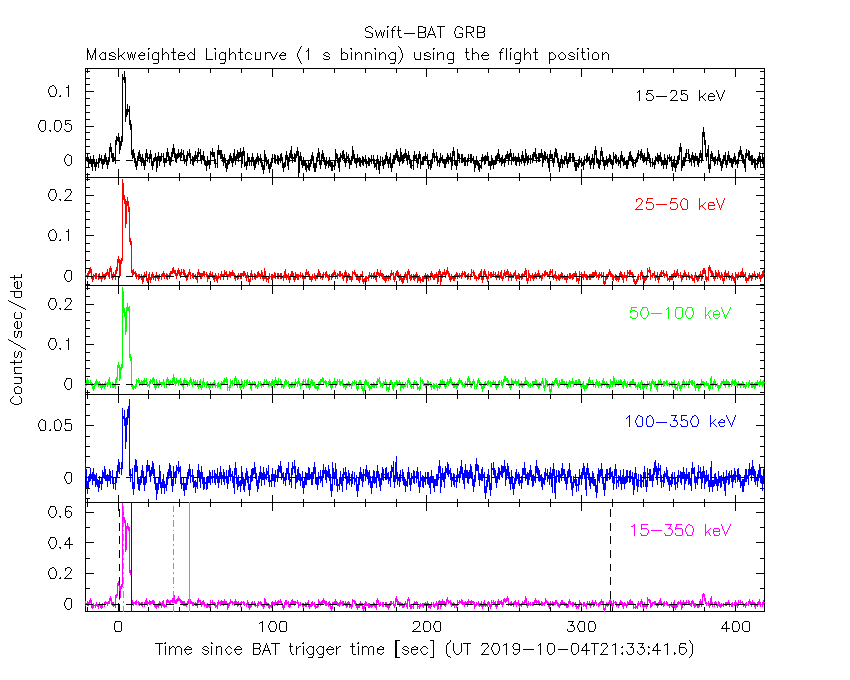
S.B. Cenko (GSFC), A. Tohuvavohu (U. Toronto) and S.J. LaPorte (PSU) for the Swift team
At 21:33:41 UT, the Swift Burst Alert Telescope (BAT) triggered and located GRB 191004B (trigger=927839) (Cenko et al. GCN Circ. 25947). Swift slewed immediately to the burst. At the time of the trigger, the initial BAT position was 123° from the Sun (9.4 hours West) and 106° from the 42%-illuminated Moon. Table 1 contains the best reported positions from Swift, and the latest XRT position can be viewed at http://www.swift.ac.uk/xrt_positions.
Cenko et al. (GCN Circ. 25947) reported the discovery with UVOT of an optical afterglow. Lipunov et al. (GCN Circ. 25948) reported the position from MASTER for the optical afterglow of this GRB. D'Elia et al. (GCN Circ. 25956) determined a redshift of 3.503 from VLT. Table 2 is a summary of GCN Circulars about this GRB from observatories other than Swift.
Standard analysis products for this burst are available at https://gcn.gsfc.nasa.gov/swift_gnd_ana.html.
As reported by Stamatikos et al. (GCN Circ. 25955),
the BAT ground-calculated position is RA, Dec = 49.200, -39.637 deg, which is RA(J2000) = 0
The mask-weighted light curve (Figure 1) shows multiple overlapping peaks starting at T-1 s, peaking at ~T+7 s, and ending at ~T+45 s.
The time-averaged spectrum from T-1.45 to T+56.17 s is best fit by a simple power-law model.
The power law index of the time-averaged spectrum is 1.10 ± 0.08.
The fluence in the 15-150 keV band is 2.5 ± 0.1 x 1
The results of the batgrbproduct analysis are available at https://gcn.gsfc.nasa.gov/notices_s/927839/BA/.
Analysis of the initial XRT data was reported by Tohuvavohu et al. (GCN Circ. 25961). We have analysed 11 ks of XRT data for GRB 191004B, from 63 s to 252.4 ks after the BAT trigger. The data comprise 142 s in Windowed Timing (WT) mode with the remainder in Photon Counting (PC) mode. The enhanced XRT position for this burst was given by Beardmore et al. (GCN Circ. 25951).
The light curve (Figure 2) can be modelled with an initial power-law decay with an index of α=2.9 (+0.6, -0.7), followed by a break at T+94.6 s to an α of 1.073 (+0.031, -0.027).
A spectrum formed from the WT mode data can be fitted with an absorbed power-law with a photon spectral index of 1.75 (+0.09, -0.07). The best-fitting absorption column is 1.4 (+6.8, -1.4) x 1
A summary of the PC-mode spectrum is thus:
Galactic foreground: 1.9 x 1
Intrinsic column: 2 (+178, -2) x 1
Photon index: 1.54 (+0.21, -0.14)
The results of the XRT team automatic analysis are available at http://www.swift.ac.uk/xrt_products/00927839.
The Swift/UVOT began settled observations of the field of GRB 191004B 69 s after the BAT trigger
(LaPorte and Cenko GCN Circ. 25978).
A fading source consistent with the XRT position (Beardmore et al. GCN Circ. 25951) is detected in the initial UVOT exposures.
Table 3 gives preliminary
magnitudes using the UVOT photometric system
(Breeveld et al. 2011, AIP Conf. Proc., 1358, 373).
No correction has been made for the expected extinction in the Milky Way
corresponding to a reddening of

Figure 1. The BAT
mask-weighted light curve in the four individual and total
energy bands. The units are counts

Figure 2. The XRT light curve.
Any data from a crosshatched region are not included in the fit.
| RA (J2000) | Dec (J2000) | Error | Note | Reference |
|---|---|---|---|---|
| 0 |
-39°38'03.9" | 0.43" | UVOT-refined | LaPorte and Cenko GCN Circ. 25978 |
| 0 |
-39°38'05.4" | 1.7" | XRT-final | UKSSDC |
| 0 |
-39°38'06.1" | 2.0" | XRT-enhanced | Beardmore et al. GCN Circ. 25951 |
| 0 |
-39°38'15.0" | 1.0' | BAT-refined | Stamatikos et al. GCN Circ. 25955 |
| Band | Authors | GCN Circ. | Subject | Observatory | Notes |
|---|---|---|---|---|---|
| Optical | Lipunov et al. | 25948 | Swift GRB191004.9: Global MASTER-Net OT detection |
MASTER | detection |
| Optical | Strausbaugh and Cucchiara | 25949 | Optical Afterglow Detection with LCO | LCO | detection |
| Optical | Heintz et al. | 25954 | NOT optical photometry | NOT | detection |
| Optical | D'Elia et al. | 25956 | VLT/X-shooter redshift | VLT | redshift |
| Optical | Watson et al. | 25958 | COATLI Optical Observations | COATLI | |
| Optical | Schady et al. | 25960 | GROND Detection of the Optical/NIR Afterglow |
GROND | detection |
| Optical | Strausbaugh and Cucchiara | 25977 | Continued Optical Afterglow Monitoring with LCO |
LCO | detection |
| Gamma-ray | Svinkin et al. | 25974 | Konus-Wind observation | Konus-Wind | Duration=~5.5 seconds Fluence=4.13(-0.40,+0.45)x1 |
| Gamma-ray | Svinkin | 25976 | Correction to Konus-Wind GCN Circ. 25974 | Konus-Wind |
| Filter | Exp(s) | Mag | ||
|---|---|---|---|---|
| b | 38697 | 38997 | 295 | >20.42 |
| uvm2 | 44827 | 45727 | 885 | >20.25 |
| u | 294 | 387 | 91 | >19.04 |
| v | 43916 | 44822 | 885 | >20.07 |
| uvw1 | 45734 | 46281 | 538 | >19.96 |
| uvw2 | 39915 | 40544 | 618 | >20.09 |
| white | 82 | 232 | 147 | |
| white | 39003 | 39909 | 885 | 20.51± 0.13 |
Table 3. UVOT observations reported by LaPorte and Cenko (GCN Circ. 25978). The start and stop times of the exposures are given in seconds since the BAT trigger. The preliminary detections and 3-σ upper limits are given. No correction has been made for extinction in the Milky Way.
October 8, 2019